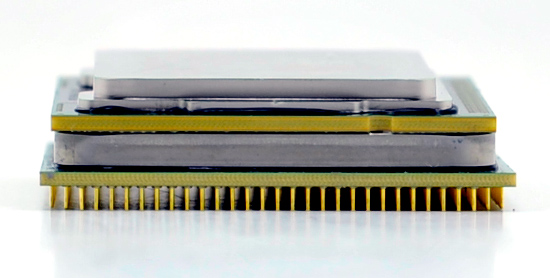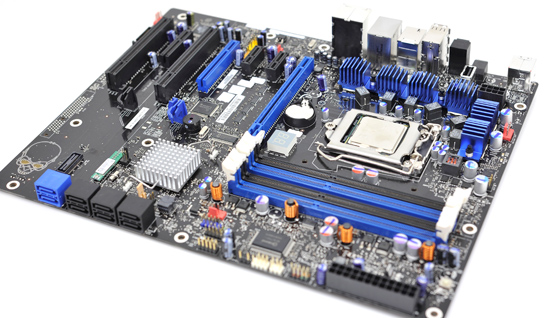Intel's Core i7 870 & i5 750, Lynnfield: Harder, Better, Faster Stronger
by Anand Lal Shimpi on September 8, 2009 12:00 AM EST- Posted in
- CPUs
Final Words
I'll start this conclusion with what AMD must do in response to Lynnfield. The Core i5 750 is a great processor at $196, in fact, it's the best quad-core CPU you can buy at that price today. In nearly every case it's faster than AMD's Phenom II X4 965 BE, despite the AMD processor costing almost another $50. Granted you can probably save some money on an integrated 785G motherboard, but if you're comparing ~$120 motherboards the AMD CPU is simply overpriced.

Lynnfield (top) vs. Phenom II (bottom)
Luckily, the solution isn't that difficult. AMD needs to lower prices. The problem is that AMD has too many products below $200 already. The Phenom II X3 and X4 series both exist below $200 and rumor has it that AMD is also going to introduce a quad-core Athlon II somewhere down there. Lynnfield's arrival causes a lot of price compression on AMD's side. The most AMD should sell the 965 BE for is $199, but if it is to remain competitive the chip needs to be priced much lower. That doesn't leave much room for other AMD CPUs. On the bright side, this could force AMD to simplify its product lines again (similar to what it has quietly been doing already).

The next thing that the Core i5 750 does is it finally ends the life of LGA-775. Just as was the case with AMD, the Core 2 Quad Q9650 is easily destroyed by the Core i5 750 and at a lower price. With significantly lower motherboard costs than the LGA-1366 chips, the Core i5 750 can actually compete in the high end LGA-775 space. It's only a matter of time before the sub-$200 LGA-775 parts are made obsolete as well.
Lynnfield power consumption is just excellent, these are the most power efficient quad-core CPUs we've ever tested. They use less power at idle than similarly clocked dual-core processors and under load they deliver better performance per watt than any of their closest competitors. Later this year we'll see 32nm dual-core Westmere start to ship for notebooks. I don't have performance data but I'd expect that early next year will be the perfect time to buy a new notebook.
Can you tell that I like the Core i5 750? Again, at $196 you can't find a better processor. Intel did its homework very well and managed to deliver something that kept AMD in check without completely upsetting the balancing of things. There's no technical reason that Intel couldn't have enabled Hyper Threading on the Core i5, it's purely a competitive move. A Core i5 750 with HT would not only defeat the purpose of most of the i7s, but it would also widen the performance gap with AMD. Intel doesn't need to maintain a huge performance advantage, just one that's good enough. While I'd love to have a 750 with HT, I'd still recommend one without it.
The Core i7 870 gets close enough to the Core i7 975 that I'm having a hard time justifying the LGA-1366 platform at all. As I see it, LGA-1366 has a few advantages:
1) High-end multi-GPU Performance
2) Stock Voltage Overclocking
3) Future support for 6-core Gulftown CPUs
If that list doesn't make you flinch, then Lynnfield is perfect. You'll save a bunch on a motherboard and the CPUs start at $196 instead of $284. We didn't have enough time with our Core i7 860 to include performance results here but my instincts tell me that at $284 that'll be the Lynnfield sweetspot. You get excellent turbo modes and Hyper Threading, without breaking $300.
Speaking of turbo, I'd say that Intel is definitely on to something here. The performance impact was small with Bloomfield, but turbo on Lynnfield is huge. My tests showed up to a 17% increase in performance depending on the workload, with most CPU-influenced scenarios seeing at least 9 or 10%. The turbo mode transitions happen fast enough to accelerate even simple actions like opening a new window. OS and application responsiveness is significantly improved as a result and it's something that you can actually feel when using a Lynnfield machine. It all works so seamlessly, you just always get the best performance you need. It's like Intel crammed the best single, dual and quad-core processors all into one package.
Perhaps that's what kept me from falling in love with Bloomfield right away. It was fast but in the same way that its predecessors were fast. If you didn't have a well threaded application, Bloomfield wasn't any better than a similarly clocked Penryn. Lynnfield's turbo modes change the game. Say goodbye to tradeoffs, the Core i5 and Core i7 are now fast regardless of thread count. It speed that is useful, it speed that you can feel, it's what truly makes Lynnfield the best desktop microprocessor of 2009. It's not just faster, it's smarter, it's better. It's why today's title borrows from Daft Punk and not Star Wars; it's not more of the same, it's something futuristic and new.
Lynnfield shows us the beginning of how all microprocessors are going to be made in the future. Even AMD is embracing turbo, we'll see it with Fusion in 2011. Extend turbo to its logical conclusion and you end up with something very exciting. Imagine a processor made up of many different cores, large and small, CPU and GPU. Each one turning on/off depending on the type of workload, and each running as fast as possible without dissipating more heat than your system can handle.
My only two complaints with Lynnfield are that the chips do require additional voltage (above stock) to overclock and of course the lack of Hyper Threading on the Core i5. It doesn't ruin the processor, but it gives us something to wish for.
Our work is never over.










343 Comments
View All Comments
goinginstyle - Thursday, September 10, 2009 - link
What is worthless here is your continued ramblings about subjects you have no actual knowledge of right now. Do you own a P55 system? If so, let's see an article from you. Really, you come over spouting off and calling everyone idiots, yet, you we do not see any articles from you at Toms about the subject matter. In fact, we do not see any comments from you anywhere else about P55. Toms, Tech Report, and AT all came to the same conclusion, presented the same type of information (although AT discussed subjects like PCIE), and yet you do not comment on those other websites.Either you are posting here because you think your negative posts will somehow get you attention that your mother never gave you or you are doing to try and look important to the people in charge at Toms. I hope to God that they never allow you to post another piece of garbage on their site. Really, that article was a straight copy and paste from several other articles on the subject along with Wikipedia information. I am surprised you were not sued for plagiarism, maybe you were and that is why you are over here.
So far, all of your ramblings have only proved your total lack of intelligence when it comes to computer components. Once again, when will we see you making comments on Toms about their similar coverage or when can you expect to see your expert PP article on the site?
eternalfantasy - Tuesday, September 8, 2009 - link
Fully agree up to the AMD part. This is the most biased review I've seen published by Anandtech to date. I think a "Buy me now!" link at the end of the article with an Intel sponsored Ad will complete the article perfectly.Stock clock speed CPU review is what highstreet mags for average Joes write about. Excluding what's importent for readers of tech sites, such as:
Clock for clock comparison
Maximum overclock with similer priced CPU/platform
is just blatent attempt at glorifying Intel's mainstream platform to look like more then what it really is. A cheaper mainstream alternative to the X58 that has been avaliable over a year ago.
PassingBy - Tuesday, September 8, 2009 - link
As released, Core i5 and 1156 Core i7 have no IGP market, so presumably people reading this review will have no interest in using an IGP.In any case, we can safely say that your prognostications like 'a brain dead platform for brain dead people' were total bullshit, as many people tried to tell you. Now, many more people can place a Nehalem-based system on their list of possible purchases. Clarkdale will extend Nehalem/Westmere to even lower price points (and yes, then you can start comparing IGPs, if you like).
TA152H - Tuesday, September 8, 2009 - link
You're really confused.Honestly, anyone who knows anything about computers would be pretty stupid to get this platform. It's fine stock, but when you throw in overclock, the i7 920 is the better choice.
But, here's your hypocrisy. This article was main for mainstream people, since there's no overclocking comparisons, really. The IGP is what makes AMD work, and they do sell their processors into this market. Anand was commenting on how AMD had to lower their prices, so within this context the entire market is applicable. You didn't understand the context, did you?
I didn't say the platform was brain-dead, although you seem to be. I said it was brain-damaged. It's a Celeron. If you look at the reviews from better sites, you can see the Bloomfield running at the same speed is faster than the brain-damaged Lynnfield. Anand really tried to obfuscate this, by using bad comparisons or those meant to show the Lynnfield in the best light, instead of just presenting the most useful information. He fooled you, because you're a moron, but not everyone.
I do like this site, or I did, but I'm really getting unnerved by the way they test to show what they want to show, instead of test and then make up their minds. It's really problematic, and it's going to bite them when more people figure this out.
imperialsoren - Tuesday, September 8, 2009 - link
You have a nasty way of conversing.IdolObserver - Wednesday, September 9, 2009 - link
It's not only his nasty way of conversing. He also doesn't have a clue what he is talking about.Zymon - Tuesday, September 8, 2009 - link
I agree in the main part - there are many aspects which seem to have been completely ignored in this, and many other reviews of Lynnfield.It seems strange that you haven't used a level playing field between compared systems: ALL 3 platforms can use DDR3 - you've used X48 for Core 2 chips, but apparently used different RAM than i5. Why on earth have you used an AM2+ board and DDR2 ram for AMD? I guess it's *only* been 9 months since AM3 became available?
As mentioned, a true clock-for-clock comparison would be VERY interesting, using the same RAM, at the same speeds and timings between platforms.
Anand Lal Shimpi - Tuesday, September 8, 2009 - link
Sorry if this wasn't made clear in the review but the Phenom II X4 965 BE used the same test platform as our review of that CPU: an AM3 motherboard with DDR3 memory.I'm out of the office now but I'll update the test tables later this evening to reflect this.
Take care,
Anand
Zymon - Tuesday, September 8, 2009 - link
Cheers for the clarification Anand!- It seemed unusual for one of your articles, hence the comment!
Laters..
snakeoil - Tuesday, September 8, 2009 - link
i want to know if those benchmarks were with the turbo enabled, which would be cheating, because that's overclocking.for every benchmark turbo must be disabled to be fair.
readers are not stupid.